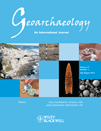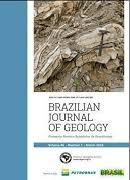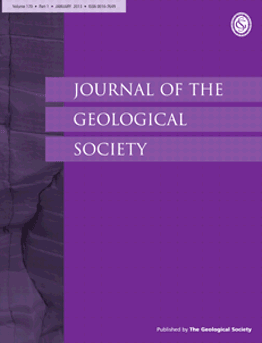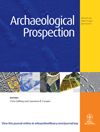
GEOARCHAEOLOGY-AN INTERNATIONAL JOURNAL
Scope & Guideline
Innovating Archaeological Understanding Through Geoscience
Introduction
Aims and Scopes
- Site Formation Processes:
Research in this area examines the processes that affect the formation and alteration of archaeological sites, including sedimentation, erosion, and human activities that create or modify these landscapes. - Provenance Studies:
This scope involves investigating the origins and distributions of raw materials used in ancient artifacts, such as ceramics and lithics, utilizing geochemical and petrographic techniques to trace their sources. - Paleoenvironmental Reconstructions:
Studies focus on reconstructing past environments and climate conditions to understand human adaptation and interactions with their surroundings, often using sediment analysis and other geological data. - Interdisciplinary Approaches:
The journal promotes interdisciplinary research that combines archaeology, geology, geography, and other fields to address complex questions about human history and environmental change. - Technological Innovations in Geoarchaeology:
This includes the application of advanced techniques such as remote sensing, GIS, and geophysical methods to enhance archaeological investigations and site management.
Trending and Emerging
- Environmental Change and Human Adaptation:
An increasing number of studies are focusing on the relationships between environmental changes (such as climate shifts and sea-level rise) and human adaptations, highlighting the dynamic interplay between societies and their environments. - Geoarchaeological Applications in Marine Contexts:
Research is trending towards the application of geoarchaeological methods in marine settings, particularly in understanding submerged prehistoric landscapes and coastal archaeological sites. - Technological Integration:
The use of advanced technologies such as machine learning, X-ray fluorescence, and 3D modeling is on the rise, enhancing the analytical capabilities of geoarchaeological research and allowing for more precise interpretations of archaeological data. - Anthropogenic Impact Studies:
There is a growing focus on understanding how ancient human activities have transformed landscapes, with studies examining soil alterations, sedimentation patterns, and other markers of anthropogenic influence. - Interdisciplinary Collaborations:
Collaborative studies that integrate insights from archaeology, anthropology, environmental science, and geology are becoming more prevalent, reflecting a holistic approach to understanding past human behaviors and environmental interactions.
Declining or Waning
- Traditional Archaeological Methods:
There seems to be a waning interest in purely traditional archaeological methodologies that do not integrate geoarchaeological perspectives, as the field increasingly emphasizes interdisciplinary approaches. - Historical Geology:
Research that focuses solely on historical geology without direct applications to archaeological contexts appears to be less prominent, as the journal's emphasis shifts toward more applied geoarchaeological studies. - Single-Site Studies:
The trend is moving away from isolated case studies towards broader comparative analyses and regional studies that consider multiple sites and their interactions within larger landscapes. - Purely Descriptive Studies:
There is a noticeable decline in papers that offer merely descriptive accounts of geological formations or archaeological findings without integrating them into larger narratives about human-environment interactions.
Similar Journals

Brazilian Journal of Geology
Illuminating the Earth's Mysteries Through ResearchBrazilian Journal of Geology, the flagship publication of the SOC BRASILEIRA GEOLOGIA, has been a beacon of geoscientific research since its inception in 2013. With an ISSN of 2317-4889 and an E-ISSN of 2317-4692, this open-access journal has facilitated the dissemination of high-quality research across various branches of geosciences, making it freely accessible to a global audience since 2014. Hailing from Brazil, the journal proudly holds a Q2 ranking in Earth and Planetary Sciences as of 2023, and ranks #73 out of 195 in Scopus, indicating its growing impact and relevance in the field. The Brazilian Journal of Geology aims to bridge diverse geological studies with interdisciplinary approaches, promoting the understanding and application of geology in addressing contemporary scientific challenges. As it converges research from 2013 to 2024, the journal not only enriches the academic landscape but also serves as a vital resource for researchers, professionals, and students eager to explore the complexities of the Earth and its processes.

Environmental Earth Sciences
Unveiling the complexities of our planet through interdisciplinary studies.Environmental Earth Sciences is a prestigious journal published by Springer, dedicated to advancing knowledge in the multifaceted fields of Earth Sciences, including Earth-Surface Processes, Environmental Chemistry, Geology, and Soil Science. With an ISSN of 1866-6280 and an E-ISSN of 1866-6299, this journal occupies a notable position in the academic landscape, consistently ranked in the Q2 category across multiple disciplines in 2023. It supports open access to foster wider dissemination of impactful research, enhancing visibility and accessibility for authors and readers alike. The journal's ongoing commitment to publishing innovative studies and reviews makes it an essential resource for researchers, professionals, and students alike. With a strong focus on addressing contemporary environmental challenges, Environmental Earth Sciences invites contributions that are both original and interdisciplinary, making a significant impact in understanding Earth dynamics and sustainability.

ACTA GEOLOGICA SINICA-ENGLISH EDITION
Pioneering Discoveries in Geology and BeyondACTA GEOLOGICA SINICA-ENGLISH EDITION is a distinguished academic journal published by Wiley, providing a platform for cutting-edge research in the field of geology. With an ISSN of 1000-9515 and E-ISSN 1755-6724, this journal has been a pivotal resource since its inception in 1988, catering to scholars and professionals until 2024. The journal is recognized for its high-quality articles, achieving a Q2 ranking in the field of Geology according to the 2023 category quartiles, and ranks #122 out of 321 in the Scopus Earth and Planetary Sciences sector, placing it within the 62nd percentile among its peers. Although currently not available as an open access publication, it remains a significant repository of knowledge that supports ongoing geological research and exploration. For researchers, students, and professionals looking to deepen their understanding of geological sciences, ACTA GEOLOGICA SINICA-ENGLISH EDITION stands as an essential journal, promoting collaboration and innovation in the earth sciences.

Morphology
Innovating Insights into Language StructureMorphology is a leading academic journal published by Springer, dedicated to the field of linguistics and language, with an impressive 2023 Category Quartile of Q1 reflecting its high impact and quality. Established in 2006, this international journal presents cutting-edge research and advancements in morphological studies, providing a vital platform for scholars and practitioners to disseminate their findings and insights. With its Scopus rank placing it in the top 10% of journals in the Arts and Humanities (Language and Linguistics), Morphology plays a pivotal role in shaping the discourse within the field. The journal maintains a commitment to excellence and rigor, catering to a wide readership that includes researchers, professionals, and graduate students eager to explore the complexities of language structure. Although currently not open access, Morphology ensures that its content is accessible through various institutional subscriptions, facilitating widespread engagement with important linguistic research.

GEO-MARINE LETTERS
Exploring the Depths of Earth and Ocean SciencesGEO-MARINE LETTERS, published by Springer, is a prestigious academic journal that has been a pivotal platform for the dissemination of innovative research in the fields of Earth and Planetary Sciences, Oceanography, Environmental Science, and Geotechnical Engineering since its inception in 1981. With an E-ISSN of 1432-1157, this journal has established itself in the Q2 quartile across multiple categories in 2023, indicating its influential position within the scientific community, as reflected by its Scopus rankings. While it currently does not offer an open access option, its rigorous peer-review process ensures the publication of high-quality research that contributes significantly to advancing our understanding of marine and geological sciences. Researchers, professionals, and students alike will benefit from the diverse scope of studies featured in GEO-MARINE LETTERS, making it an essential resource for those engaged in environmental and marine research. Situated in Germany, the journal's commitment to excellence continues to shape critical discussions and innovations in the field.

REVISTA DE LA SOCIEDAD GEOLOGICA DE ESPANA
Shaping the Future of Geology Through Collaborative InsightsREVISTA DE LA SOCIEDAD GEOLOGICA DE ESPANA, published by the SOCIEDAD GEOLOGICA DE ESPAÑA, FACULTAD DE CIENCIAS, serves as a pivotal platform for the dissemination of cutting-edge research in the field of geology. With its roots planted firmly in Spain, this journal focuses on advancing the understanding of geological processes and Earth sciences, making it an essential resource for researchers, professionals, and students in the discipline. Despite currently being classified in the Q4 category of Geology, the journal has the potential to evolve as it continues to publish high-quality scholarly articles, fostering dialogue and collaboration within the geological community. Although it operates without an open-access model, the journal ensures wide accessibility to its content through various academic databases. As it enters the converged publication phase from 2016 to 2024, REVISTA DE LA SOCIEDAD GEOLOGICA DE ESPANA remains committed to providing innovative insights and valuable contributions to the scientific body of knowledge in geology.

GEOLOGICAL QUARTERLY
Exploring Earth's Mysteries, One Quarter at a Time.GEOLOGICAL QUARTERLY, published by the Polish Geological Institute, is a respected journal in the field of geology, offering insights into Earth and planetary sciences since its inception in 2000. With an ISSN of 1641-7291 and an E-ISSN of 2082-5099, this journal serves as a vital platform for researchers, professionals, and students seeking to expand their knowledge in geological disciplines. The journal is positioned in Q3 within the geology category as of 2023 and ranks #172 out of 321 in Scopus, placing it in the 46th percentile among its peers. Although currently not an open-access publication, GEOLOGICAL QUARTERLY reflects the policy of fostering scientific communication and collaboration by disseminating valuable geological research. Its commitment to publishing original articles, reviews, and technical notes ensures that it plays a significant role in advancing geological science and its applications within the academic community. With its base in Warsaw, Poland, the journal stands as an important resource for anyone engaged in or studying the Earth sciences.

Cuaternario y Geomorfologia
Connecting Past and Present Through GeomorphologyCuaternario y Geomorfologia is a distinguished journal published by the Spanish Quaternary Research Association, focusing on the interdisciplinary study of Quaternary research, geomorphology, and related fields. With its ISSN 0214-1744 and a publication history spanning from 2012 to 2024, the journal serves as a critical platform for researchers and practitioners in geography, geology, and paleontology. Although its current Scopus rankings place it in the lower quartiles across various categories, being Q4 in Earth-Surface Processes, Geography, Planning and Development, Geology, and Paleontology, Cuaternario y Geomorfologia continues to push boundaries within its sphere, aiming to foster a deeper understanding of Earth sciences. Situated in Madrid, Spain, the journal's commitment to sharing groundbreaking research without access barriers enhances its value for academics, offering insights that drive forward the fields of Quaternary studies and beyond. Researchers, professionals, and students alike will find a rich repository of knowledge within its pages, making it an essential resource for current and aspiring experts in the discipline.

JOURNAL OF THE GEOLOGICAL SOCIETY
Exploring Earth's Mysteries Through Rigorous ResearchJOURNAL OF THE GEOLOGICAL SOCIETY, published by GEOLOGICAL SOC PUBL HOUSE, is a premier academic journal dedicated to advancing the field of geology. With a rich history dating back to 1845 and continuously published until 2024, this journal caters to a diverse audience of researchers, professionals, and students involved in earth sciences. The journal is recognized for its high impact factor, situating it in the top Q1 category in the field of geology, as indicated by its impressive Scopus rank of #49 out of 321, positioning it at the 84th percentile in Earth and Planetary Sciences. This esteemed scholarly platform promotes rigorous peer-reviewed research, ensuring that novel findings contribute to the global geological discourse. Although it operates under a subscription model, the journal's archive offers valuable insights for anyone pursuing excellence in geological research. The JOURNAL OF THE GEOLOGICAL SOCIETY stands as a vital resource for disseminating scientific knowledge and fostering educational growth within the field.

Archaeological Prospection
Discovering Connections: Bridging History and MethodologyArchaeological Prospection, published by WILEY, is an esteemed journal dedicated to advancing the field of archaeology through innovative research and methodologies. With an ISSN of 1075-2196 and an E-ISSN of 1099-0763, this journal has established a significant presence since its inception in 1994, converging its influential findings until 2024. Recognized for its high academic standards, it proudly holds a Q1 ranking in both Archaeology and History for 2023, reflecting its commitment to excellence with notable Scopus rankings that place it in the top tiers of both Arts and Humanities, and Social Sciences. By fostering rigorous scholarly dialogue and disseminating cutting-edge practices in archaeological prospection, this journal serves as an invaluable resource for researchers, professionals, and students alike, propelling collective understanding of our human past. Although it does not currently offer open access options, the depth and quality of research published within its pages remains crucial for those engaged in archaeological studies and historical exploration.